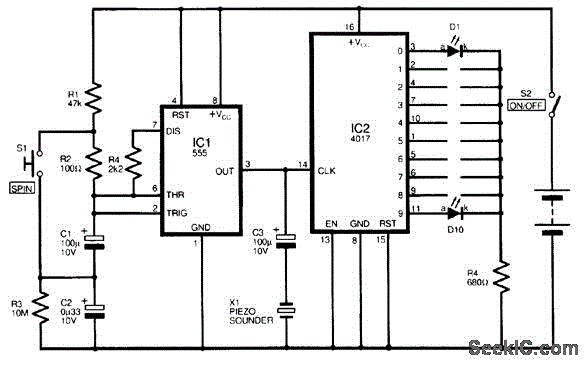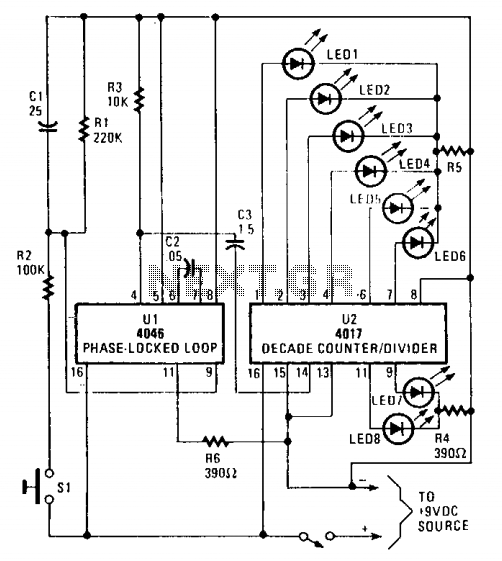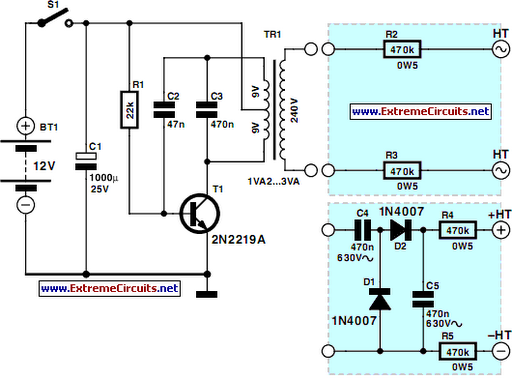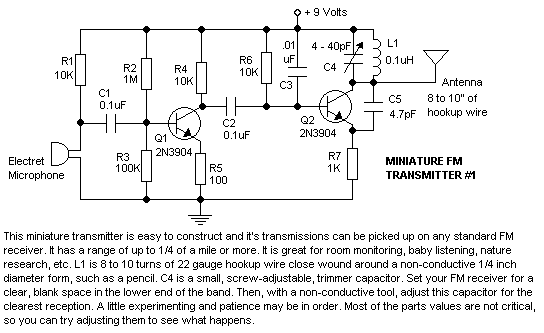
MINI ROULETTE

A circuit diagram for a mini battery-powered version of roulette is presented. This circuit utilizes a 4017 decade counter (IC2) to drive 10 LEDs. Only one LED is illuminated at any given time, which is managed by a common limiting resistor (R4). The LEDs can be arranged in an alternating red and green pattern for enhanced visual effect. The counter IC2 is clocked by IC1, a classic 555 timer configured in astable mode. When the SPIN button is pressed and released, the circuit reaches full speed, and the display gradually decelerates until it stops on a single number. The capacitor (C2) regulates the oscillator speed, while resistor (R3) mitigates instability when the LED rotation ceases. A piezo disk transducer (X1) is connected to the output of the oscillator to produce sound effects.
The described circuit operates as a compact and engaging roulette simulation, ideal for educational purposes or entertainment. The 4017 decade counter is a versatile component that counts pulses from the clock signal generated by the 555 timer. This configuration allows for the sequential illumination of each LED, creating a visually appealing effect that mimics the spinning of a roulette wheel.
The 555 timer, functioning in astable mode, continuously generates a square wave signal. The frequency of this signal is determined by the values of the timing capacitor (C2) and resistor (R3). The design choice of C2 directly impacts the speed of the LED cycling; larger capacitance will result in a slower cycle, while smaller capacitance will increase the speed. Resistor R3 plays a crucial role in ensuring that the circuit remains stable during operation, particularly when the SPIN button is activated and the LEDs are in motion.
The common limiting resistor R4 is essential for protecting the LEDs from excessive current, ensuring their longevity and consistent brightness. The arrangement of the LEDs in alternating colors not only enhances the aesthetic appeal but also helps in distinguishing the active LED during gameplay.
The inclusion of the piezo disk transducer (X1) adds an auditory element to the circuit, further enriching the user experience. This component converts the electrical oscillations from the 555 timer into sound waves, providing feedback that complements the visual display.
Overall, this mini battery-powered roulette circuit is a well-rounded project that combines principles of digital electronics, timing circuits, and sound generation, making it an excellent demonstration of basic electronic concepts.A circuit diagram for a mini battery-powered version of roulette is shown, This circuit uses a 4017 decade counter (IC2) driving 10 LEDs. Because only one LED is ever illuminated at any one time, a common limiting resistor R4 is used. They can also be placed in alternating red/green order for added effect. The counter IC2 is clocked by IC1, a clas sic 555 timer connected as an astable. When the SPIN button is pressed and then released, full speed is achieved, and then the display gradually slows down until it stops on a single number. Capacitor C2 governs the oscillator speed, and resistor R3 prevents instability when the LED rotation stops.
The piezo disk transducer, X1, is placed on the output of the oscillator to provide a sound effect. 🔗 External reference
The described circuit operates as a compact and engaging roulette simulation, ideal for educational purposes or entertainment. The 4017 decade counter is a versatile component that counts pulses from the clock signal generated by the 555 timer. This configuration allows for the sequential illumination of each LED, creating a visually appealing effect that mimics the spinning of a roulette wheel.
The 555 timer, functioning in astable mode, continuously generates a square wave signal. The frequency of this signal is determined by the values of the timing capacitor (C2) and resistor (R3). The design choice of C2 directly impacts the speed of the LED cycling; larger capacitance will result in a slower cycle, while smaller capacitance will increase the speed. Resistor R3 plays a crucial role in ensuring that the circuit remains stable during operation, particularly when the SPIN button is activated and the LEDs are in motion.
The common limiting resistor R4 is essential for protecting the LEDs from excessive current, ensuring their longevity and consistent brightness. The arrangement of the LEDs in alternating colors not only enhances the aesthetic appeal but also helps in distinguishing the active LED during gameplay.
The inclusion of the piezo disk transducer (X1) adds an auditory element to the circuit, further enriching the user experience. This component converts the electrical oscillations from the 555 timer into sound waves, providing feedback that complements the visual display.
Overall, this mini battery-powered roulette circuit is a well-rounded project that combines principles of digital electronics, timing circuits, and sound generation, making it an excellent demonstration of basic electronic concepts.A circuit diagram for a mini battery-powered version of roulette is shown, This circuit uses a 4017 decade counter (IC2) driving 10 LEDs. Because only one LED is ever illuminated at any one time, a common limiting resistor R4 is used. They can also be placed in alternating red/green order for added effect. The counter IC2 is clocked by IC1, a clas sic 555 timer connected as an astable. When the SPIN button is pressed and then released, full speed is achieved, and then the display gradually slows down until it stops on a single number. Capacitor C2 governs the oscillator speed, and resistor R3 prevents instability when the LED rotation stops.
The piezo disk transducer, X1, is placed on the output of the oscillator to provide a sound effect. 🔗 External reference





